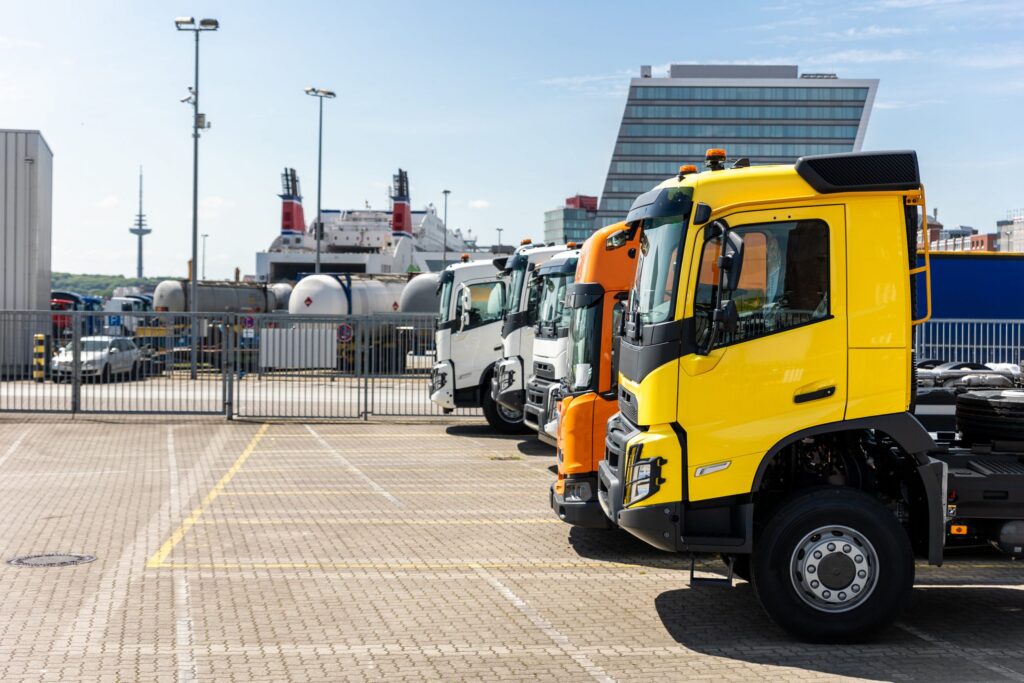A heavy goods vehicle (HGV) daily walkaround check plays a significant role in ensuring road safety standards are upheld and vehicles are kept roadworthy.
They form part of the commitment that operators make to achieve their O Licence. Drivers are therefore legally required to complete a walkaround check on a daily basis before taking their vehicle on the road.
In this comprehensive guide we will be outlining what a HGV daily walkaround check is, why they are so important to maintaining road safety and the availability of your fleet, and the options available to you to streamline your walkaround check processes.
Defining HGV daily walkaround check
A HGV daily walkaround check is a mandatory routine safety inspection that must be carried out by the driver of a heavy goods vehicle (HGV), before a journey, to ensure that the vehicle is in a safe condition to be driven.
This routine safety inspection involves walking around the vehicle and analysing it for any defects or major issues, which must be documented and reported through to resolution (if necessary), typically on an electronic device (with the aid of a walkaround check mobile app) or physical document.

As drivers are legally responsible for the condition of the heavy vehicle they are driving, it is essential that the driver carries out the walkaround check themselves.
If you’re a Transport Manager or Vehicle Operator, the DVSA has guidance on how to make walkaround checks part of your processes for keeping your vehicles safe to drive, and to ensure that you’re adhering to rules at all times. Their website is the best place to find up to date information on walkaround checks and The Highway Code.
What should a walkaround check cover?
The walkaround check should cover all aspects of the vehicle, both inside and out. This includes checking the tyres, brakes, steering, lights, mirrors, windows, bodywork, and any other safety-critical components.
Here is a list of the main components that must be checked during a HGV daily walkaround check:
- Tyres: Check the condition of the tyres, including the tread depth, sidewall damage, and pressure.
- Brakes: Check the operation of the brakes, including the service brake, the parking brake, and the trailer brakes.
- Steering: Check the operation of the steering, including the power steering, the steering wheel, and the linkages.
- Lights: Check that all the lights and indicators work correctly.
- Mirrors: Check that all the mirrors are clean and adjusted correctly.
- Windows: Check that all the windows are clean and free from damage.
- Bodywork: Check for any signs of damage or wear and tear.
- Battery: Check the battery is secure and in good condition
- Other safety-critical components: Check any other safety-critical components, such as the seatbelts, the fire extinguisher, and the hazard warning lights.
You can find the extended guidance by the DVSA here.

The driver should be checking for any signs of damage or wear and tear, and also record (as well as fully appreciate) the height of both their vehicle and load height each day. This can help prevent drivers from colliding with bridges that are not high enough to allow the vehicle to pass under it safely.
Checking the vehicle and load height would have helped prevent some of the 2000 bridge strikes recorded in 2017-2018 by Network Rail, which averages out to nearly 40 a week, and this all comes at significant cost.
If any major defects are found during the walkaround check that need attending, the driver must not drive the vehicle until the defects have been recorded in a vehicle defect report and subsequently repaired if necessary. This also extends to any issues that occur during a journey, which could mean a vehicle is repaired at the roadside or recovered until it is safe to drive.
The police and Driver and Vehicle Standards Agency (DVSA) officers enforce the requirement for HGV drivers to carry out daily walkaround checks. They have the authority to stop drivers in order to conduct checks on your vehicles, and if any issues are found they have the right to place a temporary ban on using the vehicle until they are fixed; and they can also issue fines.
We’ve made a free HGV driver daily walkaround check example sheet that you can use to start the vehicle check and defect management process for your HGVs.
Or alternatively, you can ditch the spreadsheets for a walkaround check mobile application, such as Stream, and record this data digitally, so that all of the information is easily accessible across your entire operation, and also accessible by drivers at the side of the road if they get stopped.
Here’s some additional tips
The time it takes to carry out a daily walkaround check will vary depending on the size and complexity of the vehicle. It should, however, only take a few minutes to complete a comprehensive walkaround check, or your organisation may suggest a minimum time requirement to conduct one.
Here are three key tips we recommend when carrying out a safe and effective HGV daily walkaround check:
- Always carry out the check in a well-lit area.
- Take your time and be thorough, even if you are under time pressure.
- Be aware of your surroundings and look out for hazards in the surrounding area before conducting the check.
By following these tips, you can help increase the likelihood that your HGV is in a safe condition to be driven, and that you are complying with the law prior to embarking on your journey.
There are also options on the market to streamline your walkaround check process so that you no longer have to worry about the constraints of using physical documents. Stream, for example, has a mobile app where you and your organisation can report and manage defects through to resolution, and all of this information is stored digitally and widely accessible instantaneously.
If there are any issues that require servicing or you have upcoming vehicle inspections, Stream also offers automated reminders, so that you never miss another booking. Keep your vehicles, assets, and plant machinery compliant, operational, and roadworthy, so that you spend more time out on the roads, where your vehicles should be.
For HGV fleet operators and drivers, daily vehicle inspections are necessary. What if you had a walkaround check template to help manage the process?
Walkaround checks and other vehicle maintenance tasks don’t have to be a restriction on drivers and an administrative burden on back office staff.
HGV safety is a very real concern, with very real consequences.
You could be fined up to £5,000 for non-compliance. If you’re stopped at the roadside, you could be taken to court for any serious offences found. Deaths have even been caused by failure to properly check and maintain vehicles.
We’ve made a free HGV driver daily walkaround check example sheet that you can use to start the vehicle check and defect management process for your HGVs. You can also visit the DVSA’s official website for more information and guides to completing walkaround checks.
Or you can speak to one of our experts to find out more about ditching spreadsheets and streamlining your walkaround check process with Stream.
Want to read more blog articles about walk around checks?
If you’re interested in fleet compliance and maintaining roadworthiness for your HGV fleet, these articles may also interest you:
Roadworthiness is a subject we keep on coming back on a regular basis, for example this article asks the question: ‘What does Roadworthiness Mean‘.
An element of maintain roadworthiness is completing annual tests for HGVs, buses and trailers – and how not to fail your annual vehicles tests.
Frequently Asked Questions
A HGV daily walkaround check is a mandatory routine safety inspection that must be carried out by the driver of a heavy goods vehicle (HGV), before a journey, to ensure that the vehicle is in a safe condition to be driven. This includes checking the inside and outside of the vehicle, which includes (but is not limited to) the tyres, brakes, mirrors, lights, steering, bodywork and battery.
They form part of the commitment that operators make to achieve their O Licence. Drivers are therefore legally required to complete a walkaround check on a daily basis before taking their vehicle on the road.
Yes – walkaround checks are mandatory for all of these vehicle types.








